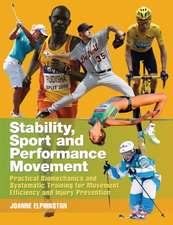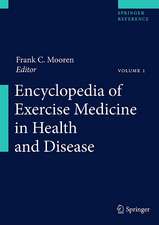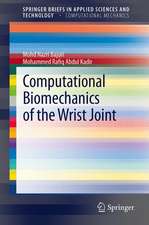Computational Biomechanics of the Hip Joint: SpringerBriefs in Applied Sciences and Technology
Autor Mohammed Rafiq Abdul Kadiren Limba Engleză Paperback – 8 oct 2013
Din seria SpringerBriefs in Applied Sciences and Technology
-
 Preț: 380.29 lei
Preț: 380.29 lei - 17%
 Preț: 360.34 lei
Preț: 360.34 lei - 20%
 Preț: 386.12 lei
Preț: 386.12 lei -
 Preț: 380.07 lei
Preț: 380.07 lei -
 Preț: 377.95 lei
Preț: 377.95 lei -
 Preț: 382.32 lei
Preț: 382.32 lei -
 Preț: 376.59 lei
Preț: 376.59 lei -
 Preț: 379.09 lei
Preț: 379.09 lei -
 Preț: 378.12 lei
Preț: 378.12 lei - 20%
 Preț: 293.83 lei
Preț: 293.83 lei -
 Preț: 344.90 lei
Preț: 344.90 lei -
 Preț: 321.36 lei
Preț: 321.36 lei -
 Preț: 264.79 lei
Preț: 264.79 lei -
 Preț: 344.90 lei
Preț: 344.90 lei -
 Preț: 356.46 lei
Preț: 356.46 lei -
 Preț: 382.95 lei
Preț: 382.95 lei -
 Preț: 355.66 lei
Preț: 355.66 lei -
 Preț: 479.67 lei
Preț: 479.67 lei -
 Preț: 415.18 lei
Preț: 415.18 lei -
 Preț: 444.52 lei
Preț: 444.52 lei - 20%
 Preț: 301.86 lei
Preț: 301.86 lei -
 Preț: 409.43 lei
Preț: 409.43 lei - 20%
 Preț: 322.17 lei
Preț: 322.17 lei -
 Preț: 355.49 lei
Preț: 355.49 lei - 15%
 Preț: 462.51 lei
Preț: 462.51 lei -
 Preț: 377.18 lei
Preț: 377.18 lei -
 Preț: 355.93 lei
Preț: 355.93 lei -
 Preț: 382.95 lei
Preț: 382.95 lei -
 Preț: 378.12 lei
Preț: 378.12 lei -
 Preț: 378.12 lei
Preț: 378.12 lei -
 Preț: 380.07 lei
Preț: 380.07 lei -
 Preț: 380.07 lei
Preț: 380.07 lei - 20%
 Preț: 326.28 lei
Preț: 326.28 lei -
 Preț: 312.68 lei
Preț: 312.68 lei -
 Preț: 356.43 lei
Preț: 356.43 lei -
 Preț: 412.30 lei
Preț: 412.30 lei - 20%
 Preț: 225.31 lei
Preț: 225.31 lei -
 Preț: 378.12 lei
Preț: 378.12 lei -
 Preț: 376.59 lei
Preț: 376.59 lei -
 Preț: 195.87 lei
Preț: 195.87 lei -
 Preț: 376.22 lei
Preț: 376.22 lei - 20%
 Preț: 324.64 lei
Preț: 324.64 lei - 20%
 Preț: 288.73 lei
Preț: 288.73 lei -
 Preț: 377.57 lei
Preț: 377.57 lei -
 Preț: 261.91 lei
Preț: 261.91 lei -
 Preț: 381.98 lei
Preț: 381.98 lei -
 Preț: 273.64 lei
Preț: 273.64 lei -
 Preț: 410.87 lei
Preț: 410.87 lei -
 Preț: 379.68 lei
Preț: 379.68 lei -
 Preț: 374.30 lei
Preț: 374.30 lei
Preț: 359.60 lei
Preț vechi: 378.54 lei
-5% Nou
Puncte Express: 539
Preț estimativ în valută:
68.81€ • 73.58$ • 57.37£
68.81€ • 73.58$ • 57.37£
Carte tipărită la comandă
Livrare economică 18 aprilie-02 mai
Preluare comenzi: 021 569.72.76
Specificații
ISBN-13: 9783642387760
ISBN-10: 3642387764
Pagini: 125
Ilustrații: IX, 113 p. 70 illus., 62 illus. in color.
Dimensiuni: 155 x 235 x 12 mm
Greutate: 0.19 kg
Ediția:2014
Editura: Springer Berlin, Heidelberg
Colecția Springer
Seriile SpringerBriefs in Applied Sciences and Technology, SpringerBriefs in Computational Mechanics
Locul publicării:Berlin, Heidelberg, Germany
ISBN-10: 3642387764
Pagini: 125
Ilustrații: IX, 113 p. 70 illus., 62 illus. in color.
Dimensiuni: 155 x 235 x 12 mm
Greutate: 0.19 kg
Ediția:2014
Editura: Springer Berlin, Heidelberg
Colecția Springer
Seriile SpringerBriefs in Applied Sciences and Technology, SpringerBriefs in Computational Mechanics
Locul publicării:Berlin, Heidelberg, Germany
Public țintă
ResearchCuprins
Introduction.- Finite element model construction.- Parameters affecting finite element predictions.- The effect of implant design on stability.- Surgical and pathological parameters affecting micro motion.- Conclusion.
Textul de pe ultima copertă
This book presents analyses of the most commonly reported failure modes of hip stems: loosening and thigh pain; both are attributed to the relative motion and instability at the bone-implant interface due to failure to achieve sufficient primary fixation. The book investigates various factors that could affect primary stability and therefore the long-term outcome of hip arthroplasty. The results complement experimental work carried out in this area as in-vitro experiments have several limitations that could be addressed through computer simulations.
Caracteristici
Presents mechanical analyses of loosening and thigh pain of hip implants Includes supplementary material: sn.pub/extras













